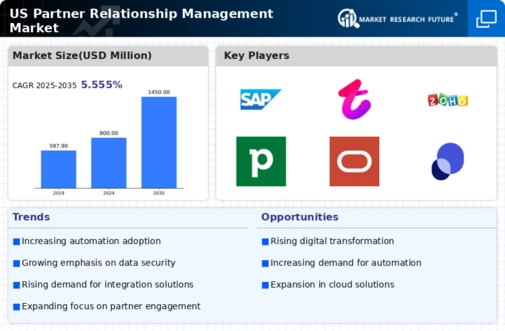Rise of Cloud-Based Solutions
The shift towards cloud-based solutions is transforming the partner relationship-management market. As organizations seek greater flexibility and scalability, cloud technologies are becoming increasingly attractive. In 2025, it is estimated that over 70% of businesses in the US will adopt cloud-based partner management solutions. This transition allows for real-time data access, improved collaboration, and reduced operational costs. Furthermore, cloud solutions often come with enhanced security features, addressing concerns related to data protection. The growing reliance on cloud technology indicates a shift in how companies manage their partnerships, enabling them to respond swiftly to market changes and partner needs. Consequently, the partner relationship-management market is likely to see a proliferation of cloud-based tools that cater to these evolving demands.
Emphasis on Performance Metrics
The partner relationship-management market is increasingly focusing on performance metrics to evaluate the success of partnerships. Organizations are recognizing the importance of data-driven decision-making in optimizing partner relationships. In 2025, it is projected that 60% of companies will implement performance measurement tools to assess partner contributions and outcomes. This trend suggests a shift towards accountability and transparency in partnerships, where businesses seek to quantify the value generated by their partners. By leveraging analytics and reporting tools, organizations can identify high-performing partners and areas for improvement. This emphasis on performance metrics not only enhances partner engagement but also drives overall business growth within the partner relationship-management market.
Growing Demand for Collaboration Tools
The partner relationship-management market is experiencing a notable surge in demand for collaboration tools. As businesses increasingly recognize the value of effective partnerships, the need for platforms that facilitate seamless communication and collaboration becomes paramount. In 2025, the market for collaboration software is projected to reach approximately $20 billion in the US, indicating a robust growth trajectory. This trend suggests that organizations are prioritizing tools that enhance partner engagement and streamline workflows. The integration of advanced features such as real-time messaging, document sharing, and project management capabilities is likely to drive the adoption of these tools within the partner relationship-management market. Consequently, companies that invest in innovative collaboration solutions may gain a competitive edge, fostering stronger relationships with their partners and ultimately enhancing overall business performance.
Increased Focus on Customer Experience
In the partner relationship-management market, there is a growing emphasis on enhancing customer experience through strategic partnerships. Organizations are increasingly aware that successful partnerships can significantly impact customer satisfaction and loyalty. In 2025, studies indicate that companies prioritizing customer experience are likely to see a 10-15% increase in customer retention rates. This trend underscores the importance of aligning partner strategies with customer-centric approaches. By leveraging insights from partner interactions, businesses can tailor their offerings to meet customer needs more effectively. As a result, the partner relationship-management market is evolving to incorporate tools and strategies that facilitate better understanding and engagement with end customers, ultimately driving mutual success for both partners and their clientele.
Integration of Artificial Intelligence
The integration of artificial intelligence (AI) is poised to revolutionize the partner relationship-management market. AI technologies are increasingly being utilized to automate processes, analyze data, and enhance decision-making. In 2025, it is anticipated that AI-driven solutions will account for approximately 25% of the partner management software market in the US. This integration allows organizations to gain deeper insights into partner behavior, predict trends, and personalize interactions. Moreover, AI can streamline administrative tasks, freeing up resources for strategic initiatives. As businesses continue to embrace AI, the partner relationship-management market is likely to evolve, offering innovative solutions that enhance partner collaboration and drive mutual success.

















Leave a Comment